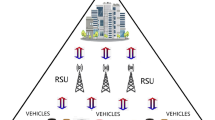Abstract
With vehicular ad hoc networks (VANETs) increasingly becoming a term synonymous with inter-vehicle communication, a lot of research is being carried out in this line to provide enhanced services. This paper proposes an efficient routing algorithm to improve energy, enhance security and maximize throughput in VANETs which is called as Energy Sources Based Resource Key Distribution and Allocation (ESBRKD-A). The performance of ESBRKD-A is analyzed in network simulator (NS2). The experimental results show that it generates 86% throughput and reduces the routing delay by up to 13% in comparison with two existing protocols viz., cross-layer optimization for heterogeneous energy and optimal scheduling in energy harvesting. ESBRKD-A also increases the lifetime of the network.






Similar content being viewed by others
References
Fung CJ, Zhu Q (2016) FACID: a trust-based collaborative decision framework for intrusion detection networks. Ad Hoc Netw. https://doi.org/10.1016/j.adhoc.2016.08.014
Bao K, Matyjas JD (2018) Intelligent software-defined mesh networks with link-failure adaptive traffic balancing. IEEE Trans Cognit Commun Netw 4:266–276
Bozorgi AM, Farasat M, Mahmoud A (2017) A time and energy efficient routing algorithm for electric vehicles based on historical driving data. IEEE Trans Intell Veh 2(4):308–320
Chen W, Lea C-T (2017) Opportunistic routing and scheduling for wireless networks. IEEE Trans Wirel Commun 16(1):320–331
Rajeshwari SR, Seenivasagam V (2016) Comparative study on various authentication protocols in wireless sensor networks. Sci World J 2016:6854303
Singh AK (2015) Identity-based key distribution for wireless sensor networks using cryptographic techniques. Int J Emerg Technol 6(1):69–72
Shakshuki EM, Kang N, Sheltami TR (2013) EAACK—a secure intrusion-detection system for MANETs. IEEE Trans Ind Electron 60:1089–1098
Divya R (2015) Analysis of multimodal biometric fusion based authentication techniques for network security. Int J Secur Appl 9(4):239–246
Rafik O, Feham M (2012) RSAED robust and secure aggregation of encrypted data in wireless sensor networks. Int J Netw Secur Appl (IJNSA). https://doi.org/10.5121/ijnsa.2012.4601
Chang SY, Lin YH (2013) CDMA: concealed data aggregation scheme for multiple applications in wireless sensor networks. IEEE Trans Knowl Data Eng 25(7):1471–1483
Dietrich D (2009) On the lifetime of VANETs. ACM Trans Sensor Netw 5(1):5–39
Rezaei Z, Mobininejad S (2012) Energy saving in wireless sensor networks. Int J Comput Sci Eng Surv (IJCSES) 3(1):23–37
Stojmenovic S, Olariu I (2006) Design guidelines for maximizing lifetime and avoiding energy holes in sensor networks with uniform distribution and uniform reporting. In: International Conference on Computer Communications
Passarella A, Anatasi G, Conti M (2009) Energy conservation in VANETs. Elsevier Ad hoc Netw 7:537–568
Lian J, Naik K, Agnew GB (2006) Data capacity improvement of VANETs using non-uniform sensor distribution. In: International Journal of Distributed Sensor Networks, pp 121–145
Khan MA, Sher A, Hameed AR, Jan N, Abassi JS, Javaid N (2016) Network lifetime maximization via energy hole alleviation in wireless sensor networks. In: Advances on broad-band wireless computing, communication and applications, pp 279–290
Shen J, Tan H (2015) Enhanced secure sensor association and key management in wireless body area networks. J Commun Netw 17(5):453–462
Huang CJ (2009) Using particle swam optimization for QoS in ad-hoc multicast. Eng Appl Artif Intell 22:1188–1193
Jeong J (2005) A solution of search multicast routing tree based on extended simulated annealing algorithm. WSEAS Trans Math 4:218
Liu T (2013) Avoiding energy holes to maximize network lifetime in gradient sinking sensor networks. Wirel Pers Commun 70(2):581–600
Doss MAN, ChristyAA, Raja K (2018) Modified hybrid multilevel inverter with reduced number of switches for PV application. J Ambient Intell Human Comput
Patil PR (2010) Data aggregation in wireless sensor network. In: International Conference on Computational Intelligence and Computing Research
Narasimharao GB, Lakshmi AJ, Kiran PS (2017) Proficient energy hole prevention scheduling in wireless sensor networks. In: International Conference on Communication and Electronics Systems (ICCES)
Chen X, Das SK (2008) Avoiding energy holes in VANETs with non-uniform node distribution. IEEE Trans Parallel Distrib Syst 19:710–720
Author information
Authors and Affiliations
Corresponding author
Additional information
Publisher's Note
Springer Nature remains neutral with regard to jurisdictional claims in published maps and institutional affiliations.
Rights and permissions
About this article
Cite this article
Prakash, G., Krishnamoorthy, R. & Kalaivaani, P.T. Resource key distribution and allocation based on sensor vehicle nodes for energy harvesting in vehicular ad hoc networks for transport application. J Supercomput 76, 5996–6009 (2020). https://doi.org/10.1007/s11227-019-03069-0
Published:
Issue Date:
DOI: https://doi.org/10.1007/s11227-019-03069-0




